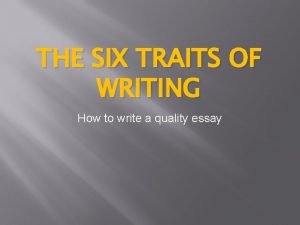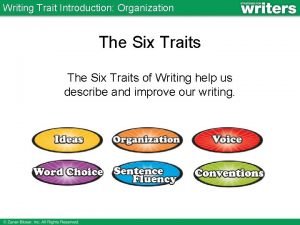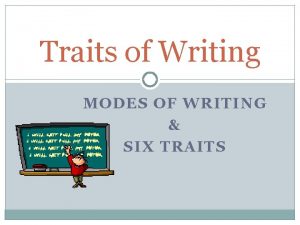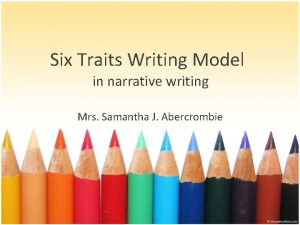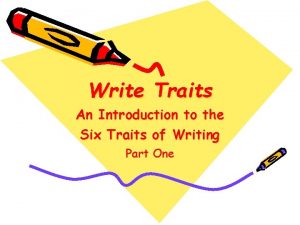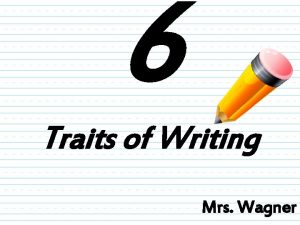Six Traits of Writing Where did the traits














- Slides: 14

Six Traits of Writing Where did the traits originate?

Ideas are the content of the message—what the writing says.

Ideas A Writer Should: Prewriting: n n n Focus on subject and make a list of ideas Take double entry notes Group and grow ideas Drafting n n n Narrow the topic to something specific. Use a fresh, original perspective State and clarify main points Provide documented support, elaboration, anecdotes, images and details Show/Don’t Tell

Organization o Organization is the internal structure of the piece—how the whole piece of writing is shaped.

Organization A Writer should: Drafting/Revising: n n n Use an inviting lead to hook the reader Use logical and effective order (chronological order) Use smooth transitions Arrange ideas into paragraphs Place supporting details where appropriate Conclusion with a clincher

Voice is the writer’s own interest added to the writing–what makes a reader feel, respond, and want more. “heart and soul of the writing” --NREL

Voice A writer should: n n Write with interest and enthusiasm Use language that brings the topic to life Match level of formality with purpose and audience Hold the reader’s interest

Word Choice is the skillful selection of words to create meaning.

Word Choice A writer should: Drafting/Revising/Editing: n Use words that create a mental picture for the reader n Use powerful action verbs n Use specific nouns and adjectives n Use language that is natural and not overdone n Match your word choices to your intended level of formality

Sentence Fluency is the way words are connected within and between sentences.

Sentence Fluency A writer should: Drafting and especially revising: n n n Make sentences grow by adding to them to clarify and illustrate your meaning Combine sentences Try for sentence rhythm Vary sentence beginning, structure, and length Fix sentences that are choppy, incomplete, or rambling

Conventions includes punctuation, spelling, grammar, usage, capitalization, and paragraph indentation.

Conventions A writer should: Editing: o Turn in a clean, edited, and polished draft o Correct use of spelling, grammar, and punctuation n Comma, apostrophe, quotation marks n Pronoun reference n Agreement—subject/verb; pronoun/antecedent n Verb tense shifts n Capital letters n Usage problems n Contractions

Works Cited Collins, Jim. Improving Writing with Six Traits and Writing Strategies: One Problem at a Time Powerpont. http: //gse. buffalo. edu/org/writingstrategies/pdffiles/ 14_6 Traits_Final. Review. pdf Heidi-Knobloch, Jennifer and Jody Drake. The Six Traits of Writing. Power. Point.
 Six traits of effective writing
Six traits of effective writing A polygon with six congruent sides and six congruent angles
A polygon with six congruent sides and six congruent angles Organization trait
Organization trait Six character traits
Six character traits Qualitative traits vs quantitative traits
Qualitative traits vs quantitative traits Qualitative traits vs quantitative traits
Qualitative traits vs quantitative traits Qualitative traits vs quantitative traits
Qualitative traits vs quantitative traits Hát kết hợp bộ gõ cơ thể
Hát kết hợp bộ gõ cơ thể Lp html
Lp html Bổ thể
Bổ thể Tỉ lệ cơ thể trẻ em
Tỉ lệ cơ thể trẻ em Gấu đi như thế nào
Gấu đi như thế nào Chụp tư thế worms-breton
Chụp tư thế worms-breton Hát lên người ơi
Hát lên người ơi Các môn thể thao bắt đầu bằng từ đua
Các môn thể thao bắt đầu bằng từ đua
